Nesting materials play a crucial role in the care of finches, particularly when it comes to successful breeding. Providing appropriate materials and nesting sites is essential for ensuring the health and wellbeing of these delicate birds. Understanding the importance of suitable nesting materials is key to creating a nurturing environment for your finches.
- Proper nesting materials are crucial for successful breeding in finches.
- Artificial nesting sites, such as plastic nest boxes, are recommended for their ease of cleaning and disinfection.
- Different finch species have preferences for specific nest styles.
- Providing live, nontoxic plants allows finches to build their own nests.
- It is important to avoid synthetic fibers and certain materials that can lead to fungal growth.
Choosing the Right Nesting Materials
Nesting materials play a crucial role in the successful breeding of finches. Providing suitable materials is essential for creating a conducive nesting environment that promotes the health and wellbeing of these birds. When it comes to choosing the right nesting materials, there are several factors to consider, including the type of materials and their impact on finch health.
Types of Nesting Materials:
When selecting nesting materials for finches, the choice between natural and synthetic materials is important. Natural materials, such as burlap, newspaper shreds, coconut fiber, and facial tissue, are preferred as they mimic the materials that finches would encounter in their natural habitats. These materials are non-toxic and provide a safe and comfortable environment for nesting.
On the other hand, synthetic materials should be avoided as they can cause harm to the finches. Synthetic fibers, in particular, can lead to the growth of fungus, which can be detrimental to the birds’ health. It is important to prioritize the use of natural materials to ensure the wellbeing of your finches.
“Natural materials, such as burlap, newspaper shreds, coconut fiber, and facial tissue, are preferred as they mimic the materials that finches would encounter in their natural habitats.”
Variety in Nesting Materials:
Providing a variety of nesting materials is beneficial for meeting the preferences of different finch species. Each species may have unique preferences when it comes to the materials they use for building their nests. By offering a range of options, you increase the likelihood of attracting a diverse range of finches to your nesting sites and promoting successful breeding.
To summarize, choosing the right nesting materials is crucial for the health and wellbeing of finches. Natural materials, such as burlap, newspaper shreds, coconut fiber, and facial tissue, are preferred over synthetic alternatives. By providing a variety of materials, you can cater to the preferences of different finch species and increase the chances of successful breeding. Remember to avoid synthetic fibers and materials that may promote fungal growth, and prioritize the use of safe and non-toxic materials.
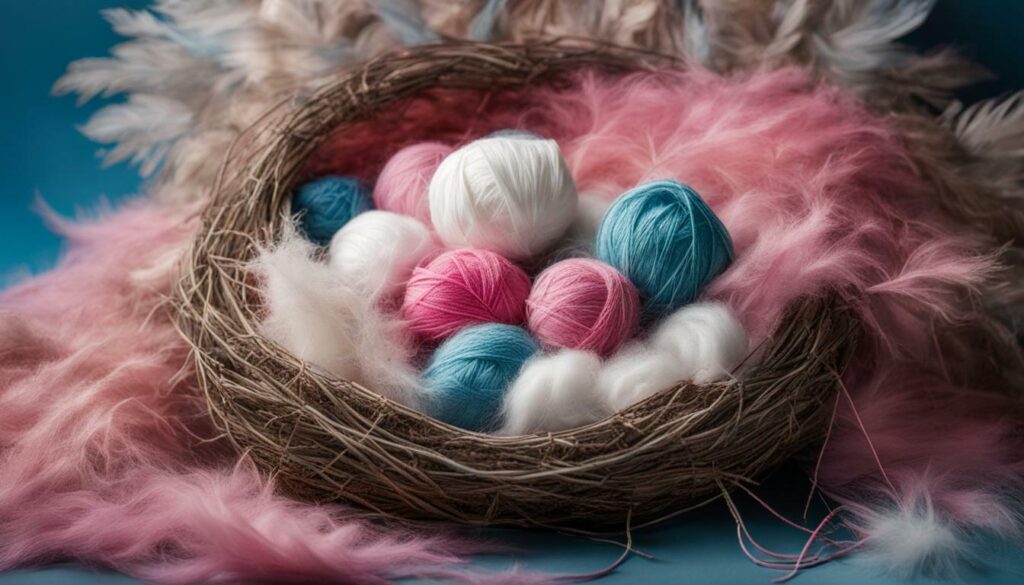
| Natural Nesting Materials | Synthetic Nesting Materials |
|---|---|
| Burlap | Synthetic fibers |
| Newspaper shreds | Nylon |
| Coconut fiber | Polyester |
| Facial tissue | Acrylic |
Providing Suitable Nesting Sites
When it comes to finch care, providing suitable nesting sites is of utmost importance. While some finches may attempt to lay their eggs in unsuitable locations like seed dishes or potted plants, it is crucial to offer appropriate nesting sites that mimic their natural habitat. The right nesting site can significantly contribute to successful breeding and the overall wellbeing of your finches.
Artificial nesting sites, such as plastic nest boxes, are highly recommended for finches. These nest boxes offer several advantages, including ease of cleaning and disinfection, which helps maintain the hygiene of the nesting environment. By providing plastic nest boxes, you create a safe and comfortable space for your finches to lay their eggs and rear their young.
Tips for Nesting Site Placement
When positioning the nesting site, it is important to consider the finches’ preferences. Nest boxes should be placed in elevated and secluded areas, away from direct sunlight and drafts. This helps provide the ideal environment for breeding and ensures the safety and comfort of your finches.
Creating multiple nesting options is also beneficial, as different finch species may have preferences for specific nest styles. Some finches may prefer half-open nests, while others may favor nests with U-shaped entry holes. Offering a variety of nesting styles caters to their individual preferences and increases the chances of successful breeding.
| Nesting Site Placement Tips |
|---|
| Elevated position |
| Secluded area |
| Away from direct sunlight and drafts |
| Provide multiple nesting options |
By following these tips and providing suitable nesting sites for your finches, you create an environment that encourages breeding success and fosters the overall wellbeing of your feathered friends.
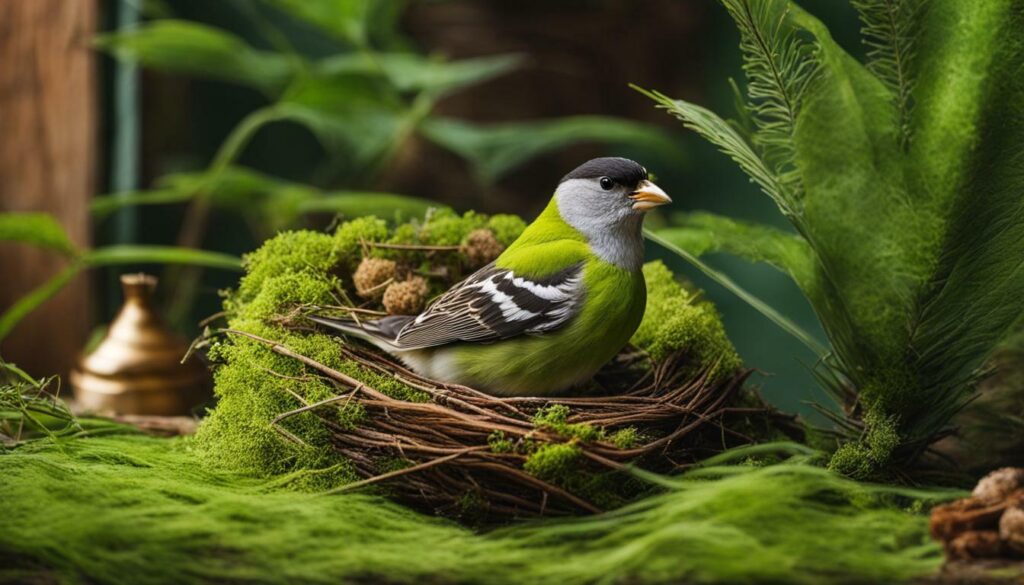
Nesting materials play a crucial role in the successful breeding of finches. Providing suitable materials and nesting sites is essential for their health and wellbeing. While artificial nesting sites like plastic nest boxes are recommended for easy cleaning and disinfection, offering natural nesting materials can also greatly benefit finches. Live, nontoxic plants create opportunities for finches to build their own nests, mimicking their natural habitat and allowing for instinctive behaviors.
When it comes to choosing nesting materials, it is important to avoid synthetic fibers and certain materials like hay, soil, and eucalyptus leaves, as these can promote fungal growth and pose a risk to finches’ health. Instead, opt for safe and suitable materials such as burlap, shreds of newspaper, coconut fiber, and shreds of facial tissue. Providing a variety of nesting materials is beneficial as different finch species may have preferences for specific textures and materials.
“By offering a diverse selection of nesting materials, finch owners can cater to the preferences of their feathered friends and provide them with a comfortable and safe environment to raise their young.”
Furthermore, the location of the nest is crucial for finches’ nesting success. Nest boxes should be placed in elevated and secluded areas, away from disturbances. Offering multiple nesting options throughout the enclosure ensures that finches can choose the most suitable spot for their specific needs. It is important to keep the nest materials dry and replace them after each clutch to prevent the growth of pathogenic organisms.

- Natural nesting materials, like live plants, are beneficial for finches to exhibit natural nest-building behaviors.
- Avoid synthetic fibers and materials that can promote fungal growth.
- Provide a variety of suitable materials, such as burlap, newspaper shreds, coconut fiber, and facial tissue.
- Choose elevated and secluded locations for nest boxes, with multiple nesting options available.
- Keep the nest materials dry and replace them after each clutch to maintain hygiene.
Table 4: Recommended Natural Nesting Materials for Finches
| Material | Benefits |
|---|---|
| Burlap | Durable and easily manipulated by finches for nest building. |
| Newspaper Shreds | Provides a soft base for nesting and can be easily replaced. |
| Coconut Fiber | Naturally resistant to fungus and mites, while offering good insulation. |
| Facial Tissue Shreds | Soft and easily accessible for nest construction. |
Safety Considerations for Nesting Materials
When it comes to nesting materials for finches, safety is of utmost importance. Choosing the right materials can ensure the health and wellbeing of your feathered friends. It is crucial to avoid materials that may pose a risk to their health or promote the growth of pathogenic organisms. By taking the necessary precautions, you can create a safe and comfortable nesting environment for your finches.
One key recommendation is to steer clear of synthetic fibers. These materials can be harmful to finches and may cause respiratory issues. It is best to opt for natural materials that are non-toxic and safe for your birds. Some suitable options include burlap, shreds of newspaper, coconut fiber, and shreds of facial tissue. These materials provide a soft and cozy nesting experience for your finches without compromising their health.
Another important consideration is maintaining hygiene in the nest. Finches are susceptible to fungal infections, especially when exposed to damp or dirty nesting materials. It is essential to keep the materials dry and replace them after each clutch. This helps prevent the growth of pathogenic organisms and ensures a clean and healthy nesting environment.
By prioritizing safety and following these recommendations, you can create a nurturing space for your finches to thrive. Providing suitable nesting materials that are free of harmful substances and maintaining proper hygiene will contribute to the overall wellbeing of your birds.
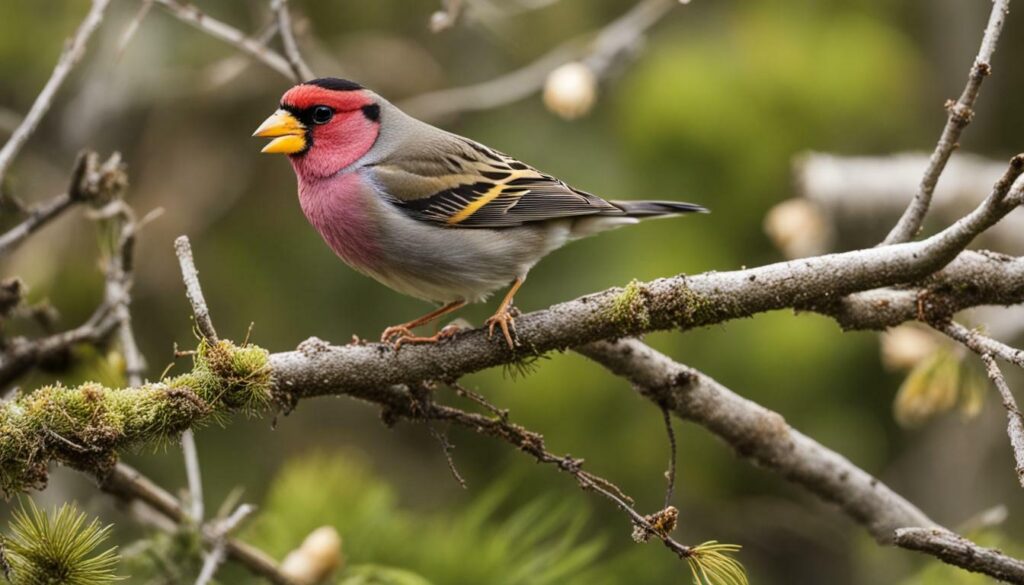
| Safety Recommendations for Nesting Materials |
|---|
| Avoid synthetic fibers |
| Choose natural, non-toxic materials |
| Use burlap, newspaper shreds, coconut fiber, and facial tissue |
| Keep nesting materials dry |
| Replace materials after each clutch |
Variety in Nesting Materials
Nesting materials play a crucial role in the successful breeding of finches. Providing a variety of suitable materials is essential to cater to the preferences of different finch species. Offering a range of options allows finches to choose materials that they are most comfortable with, enhancing their overall wellbeing and breeding success.
When it comes to selecting appropriate nesting materials, it is important to consider the specific needs of finches. Synthetic fibers should be avoided, as they can be harmful to their health. Instead, opt for natural materials such as burlap, newspaper shreds, coconut fiber, and facial tissue. These materials are safe for finches and provide the necessary comfort and insulation for their nests.
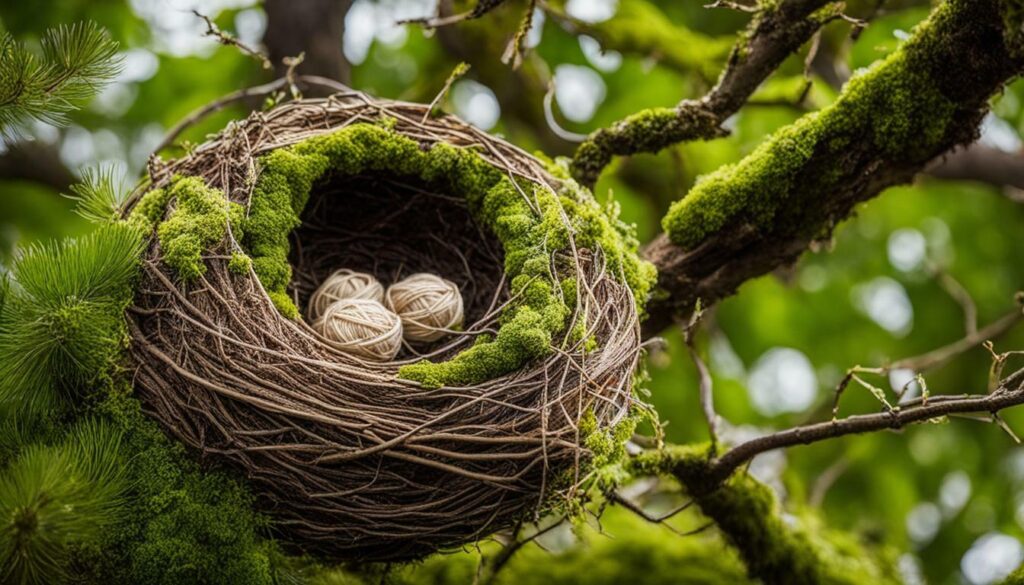
In addition to a variety of materials, the location of the nest is also vital. It is crucial to provide elevated and secluded nesting sites to give finches a sense of security. Multiple nesting options should be available to accommodate the preferences of different finch species. By creating a conducive nesting environment, finches are more likely to engage in breeding activities, resulting in a higher chance of successful reproduction.
| Material | Advantages |
|---|---|
| Burlap | Provides insulation and comfort |
| Newspaper shreds | Readily available and easy to replace |
| Coconut fiber | Natural, biodegradable, and safe for finches |
| Facial tissue shreds | Soft and lightweight, suitable for nest building |
By offering a variety of nesting materials and creating suitable nesting sites, finch owners can enhance the overall wellbeing and breeding success of their beloved birds. Experimenting with different materials and observing finches’ preferences can be a rewarding experience that fosters a deeper understanding of these fascinating creatures.
Maintaining Nesting Material Hygiene
Proper nest material hygiene is crucial for the health and wellbeing of finches. Regular maintenance and replacement of nest materials help prevent the growth of pathogenic organisms that can harm the birds. It is important to keep the materials dry and clean to ensure a safe nesting environment.
When choosing nest materials, it is essential to avoid certain materials that can lead to fungal growth. Synthetic fibers, hay, soil, and eucalyptus leaves should be avoided as they can create a damp environment conducive to fungal growth.
Instead, consider using suitable materials such as burlap, shreds of newspaper, coconut fiber, and shreds of facial tissue. These materials are safe, non-toxic, and provide nesting options that finches can easily manipulate to build their nests.
Remember to replace the nest materials after each clutch. This helps maintain cleanliness and prevents the accumulation of bacteria and other harmful organisms. Regular replacement ensures that the nesting environment remains hygienic for the finches and promotes their overall health.
Table: Recommended Nesting Materials
| Material | Advantages |
|---|---|
| Burlap | Durable and easy to manipulate |
| Newspaper shreds | Readily available and safe for finches |
| Coconut fiber | Natural material that provides insulation |
| Facial tissue shreds | Soft and easily shaped into nests |
By maintaining nest material hygiene and using suitable nesting materials, finch owners can create a safe and comfortable environment for their birds. Regular replacement and adherence to safe material choices contribute to the overall wellbeing of the finches and promote successful breeding.
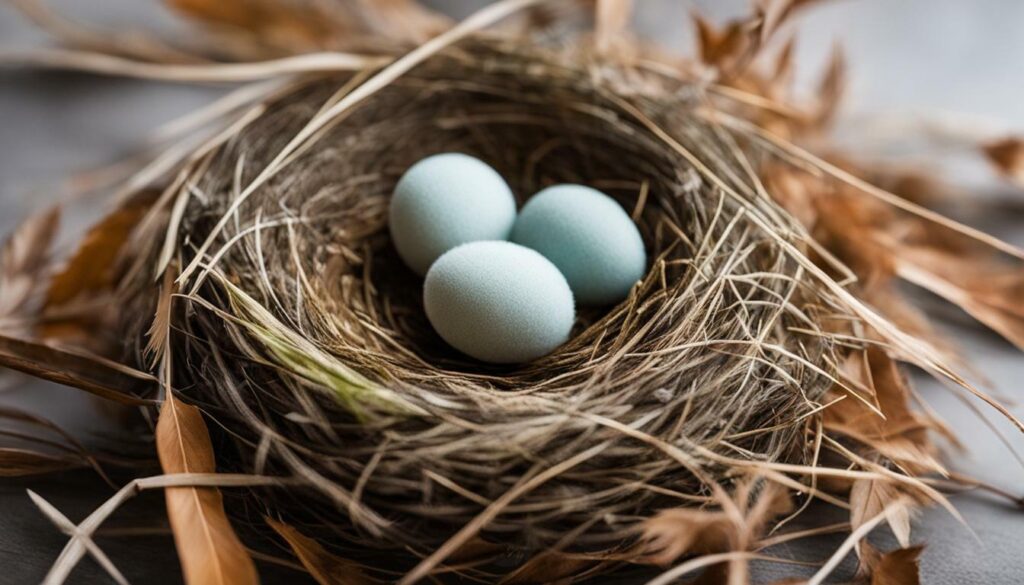
When it comes to providing suitable nesting sites for finches, artificial options like plastic nest boxes offer several advantages. These nest boxes are highly recommended due to their ease of cleaning and disinfection, which contributes to the overall health and hygiene of the nesting environment.
Plastic nest boxes are designed with the aim of providing a safe and comfortable space for finches to nest. They can be easily installed in aviaries or cages, offering a convenient solution for finch owners. Cleaning and disinfecting these nest boxes is a simple process, ensuring a clean and safe environment for the birds.
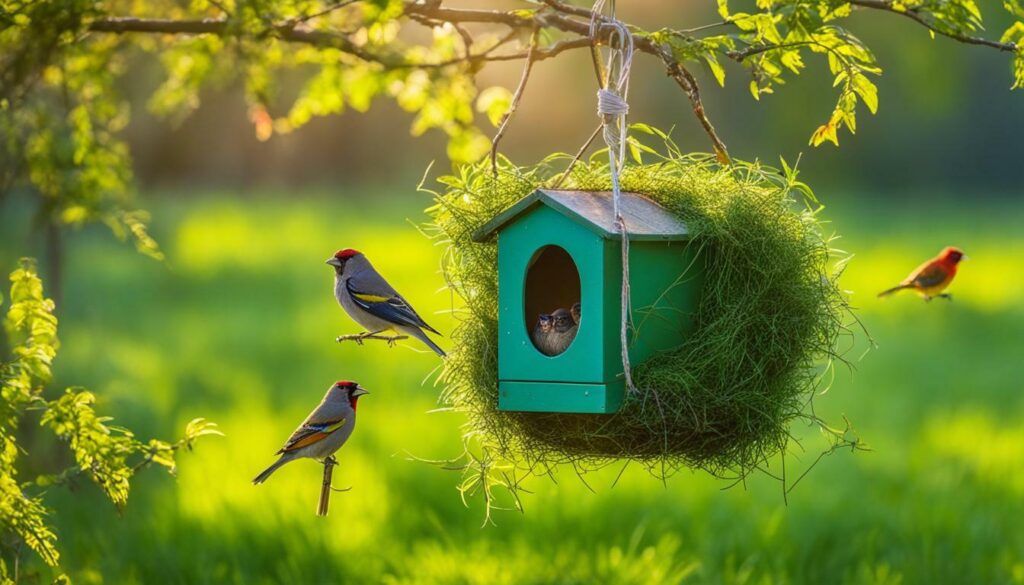
| Advantages of Plastic Nest Boxes |
|---|
| Easy Cleaning: Plastic nest boxes can be easily cleaned with mild soap and water, reducing the risk of contamination and disease transmission. |
| Disinfection: These nest boxes can be easily disinfected using bird-safe disinfectants, ensuring a clean and healthy nesting environment. |
| Durability: Plastic nest boxes are made from sturdy materials that are resistant to wear and tear, providing a long-lasting nesting solution for finches. |
| Size and Design: Plastic nest boxes are available in various sizes and designs to suit different finch species, offering them a comfortable and secure nesting space. |
| Easy Monitoring: These nest boxes often have access hatches or removable lids, allowing easy monitoring of eggs and chicks without disturbing the nesting process. |
By providing plastic nest boxes as artificial nesting sites, finch owners can ensure a clean and safe environment for their birds, promoting successful breeding and overall wellbeing. It is important to choose nest boxes that are appropriate for the specific finch species being cared for, ensuring a comfortable and secure nesting space. With regular cleaning and disinfection, these nest boxes can contribute to the health and happiness of finches, allowing them to thrive in their nesting environment.
Finch Species Preferences for Nest Styles
When it comes to nesting, different finch species have their own unique preferences for nest styles. Understanding these preferences can play a crucial role in ensuring successful breeding and optimal finch care.
Some finch species, such as the zebra finch, prefer half-open nests with a shallow cup shape. These nests provide both protection and visibility, allowing the parent birds to keep an eye on their eggs or chicks. Other species, like the Gouldian finch, prefer deep, dome-shaped nests with U-shaped entry holes. These nests offer a sense of security and privacy, creating a suitable environment for nesting and raising young.
Providing a variety of nest styles is important to accommodate the preferences of different finch species. By offering a selection of nest boxes with various shapes and sizes, finch owners can ensure that their birds have the opportunity to choose a nest that suits their individual needs and instincts.
| Finch Species | Preferred Nest Style |
|---|---|
| Zebra finch | Half-open nest with a shallow cup shape |
| Gouldian finch | Deep, dome-shaped nest with U-shaped entry hole |
Understanding finch species preferences for nest styles not only promotes successful breeding but also contributes to the overall health and wellbeing of the birds. By providing suitable nesting options, finch owners can create an environment that mimics their natural habitat, leading to happier and healthier finches.
Section 10: The Learning-Based Behavior of Nest Building
The process of nest building in finches is a fascinating example of learning-based behavior. Recent research has shown that birds’ past experiences in successfully raising chicks significantly influence their choice of nesting materials. This behavior highlights the importance of providing suitable nesting materials for finches to ensure their breeding success.
Studies have shown that finches, like other birds, rely on trial and error to learn the most effective nest-building techniques. They learn from their past experiences and use this knowledge to select materials that provide the necessary structure and insulation for their nests. By observing their interactions with the materials, researchers have discovered that finches exhibit preferences for specific textures, sizes, and shapes.
To facilitate this learning process, it is essential to offer a variety of nesting materials to finches. By providing options such as burlap, shreds of newspaper, coconut fiber, and shreds of facial tissue, you allow finches to experiment and choose the materials that best suit their individual preferences.
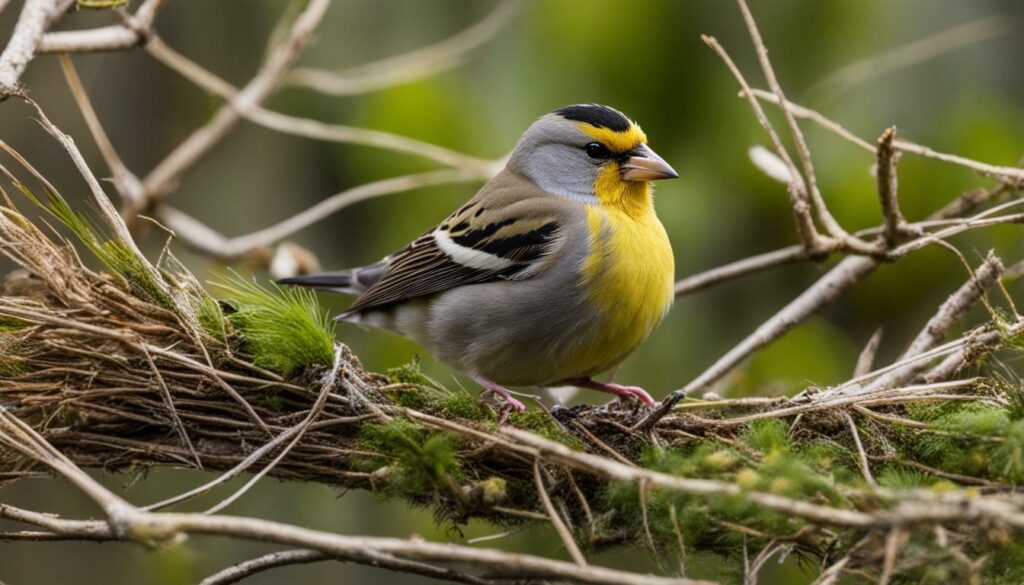 Finches building a nest with twigs and other materials.
Finches building a nest with twigs and other materials.
Understanding the learning-based behavior of nest building in finches opens up new possibilities for optimizing their care. By observing and respecting their choices, we can provide the materials they need to create safe and comfortable nests. This, in turn, contributes to their overall well-being and breeding success.
Tips for Successful Finch Nesting
Ensuring successful nesting for your finches requires careful consideration of their needs and preferences. Here are some tips to help you create an ideal nesting environment:
- Provide suitable nesting sites: Finches may attempt to lay their eggs in unsuitable locations, such as seed dishes or potted plants. To avoid this, offer artificial nesting sites like plastic nest boxes. These can be easily cleaned and disinfected, promoting a healthy nesting environment.
- Choose the right nesting materials: Avoid synthetic fibers and materials like hay, soil, and eucalyptus leaves, as they can lead to fungal growth. Instead, opt for natural materials such as burlap, shreds of newspaper, coconut fiber, and shreds of facial tissue. These materials provide a safe and comfortable nesting environment for your finches.
- Offer a variety of nesting materials: Different finch species have preferences for specific nesting materials. By providing a variety of options, you cater to their individual preferences and increase the chances of successful breeding.
- Consider the location: The location of the nest plays a crucial role in the nesting success of your finches. Choose an elevated and secluded spot, away from disturbances. Providing multiple nesting options allows finches to choose the most suitable site based on their preferences.
To maintain the hygiene of the nesting materials, keep them dry and replace them after each clutch. This prevents the growth of pathogenic organisms and ensures a healthy nesting environment for your finches.
Remember, nest building is a learning-based behavior for finches. Their past experiences in successfully raising chicks influence their choice of nesting materials. By following these tips, you can provide the optimal nesting conditions for your finches and increase the chances of successful breeding.
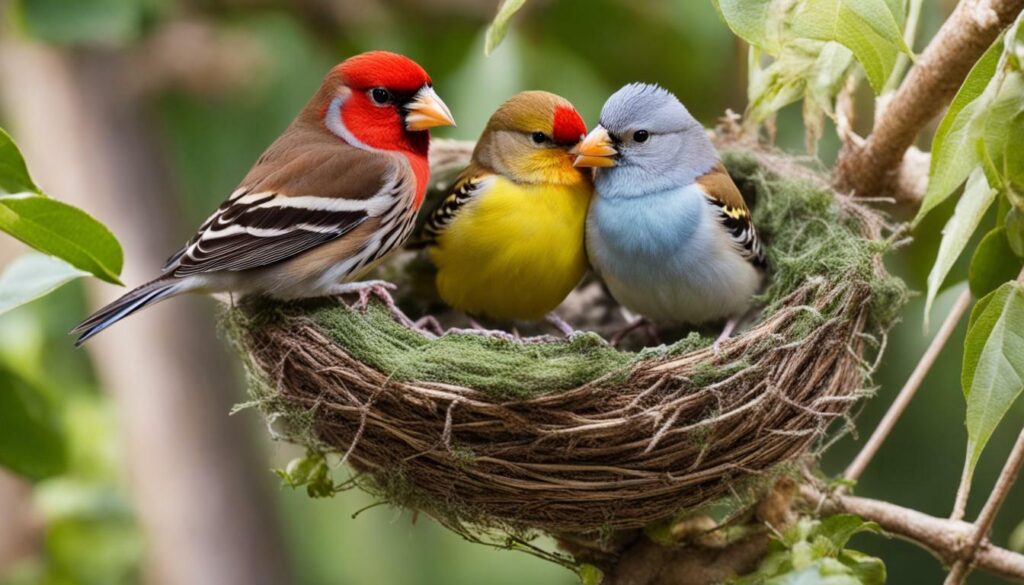
Conclusion
Nesting materials play a critical role in the care and breeding success of finches. Providing suitable materials and nesting sites is vital for creating a conducive environment for these birds to lay their eggs and raise their chicks. Unsuitable locations such as seed dishes or potted plants can disrupt the nesting process, emphasizing the need for appropriate nesting sites.
Artificial nesting sites, such as plastic nest boxes, are highly recommended due to their ease of cleaning and disinfection. These provide a safe and hygienic environment for finches to build their nests. Additionally, different species of finches may have distinct preferences for specific nest styles, such as half-open nests or those with U-shaped entry holes.
Offering live, nontoxic plants is another way to encourage finches to build their own nests. This provides them with a natural and enriching experience, allowing them to exhibit their innate instinct for nest building. It is crucial to choose suitable materials for nesting, avoiding synthetic fibers and materials like hay, soil, and eucalyptus leaves that can foster fungal growth.
Instead, suitable materials include burlap, shreds of newspaper, coconut fiber, and shreds of facial tissue. It is also important to provide a variety of nesting materials to cater to the preferences of different finch species. Elevating and secluding the nesting site, along with offering multiple options, will further encourage successful breeding.
Furthermore, maintaining nest material hygiene is essential for the health and wellbeing of finches. Keeping the materials dry and replacing them after each clutch will prevent the growth of pathogenic organisms. Additionally, studies have shown that nest building is a learning-based behavior influenced by birds‘ past experiences in successfully raising chicks.
By implementing these tips and recommendations, finch owners can ensure the optimal care of their birds and create an environment that promotes successful nesting and breeding. By providing suitable nesting materials and sites, finches can thrive and bring joy to their owners with their beautiful nests and adorable chicks.
FAQ
Q: Why are nesting materials important for finch breeding?
A: Nesting materials are crucial for successful breeding in finches. They provide the necessary materials for finches to construct their nests, ensuring a suitable environment for egg-laying and raising chicks.
Q: What are some recommended artificial nesting sites for finches?
A: Plastic nest boxes are recommended for finches due to their ease of cleaning and disinfection. They provide a suitable and hygienic environment for nesting.
Q: What type of nest styles do different finch species prefer?
A: Different finch species may have preferences for specific nest styles. Some may prefer half-open nests, while others may prefer nests with U-shaped entry holes. Providing options that cater to their preferences can increase breeding success.
Q: Can finches build their own nests using live plants?
A: Yes, providing live, nontoxic plants can give finches the opportunity to build their own nests. This allows them to exhibit their natural behaviors and instincts while providing a suitable nesting environment.
Q: What materials should be avoided when providing nesting materials for finches?
A: It is important to avoid synthetic fibers and certain materials like hay, soil, and eucalyptus leaves, as they can lead to fungal growth. Instead, suitable materials include burlap, shreds of newspaper, coconut fiber, and shreds of facial tissue.
Q: How should nest material hygiene be maintained?
A: Nest material should be kept dry and replaced after each clutch to prevent the growth of pathogenic organisms. This helps to maintain a clean and healthy nesting environment for finches.
Q: Why are plastic nest boxes recommended as artificial nesting sites?
A: Plastic nest boxes are recommended due to their ease of cleaning and disinfection. They provide a hygienic and safe nesting environment for finches, which contributes to their overall health and wellbeing.
Q: How can I cater to the preferences of different finch species when it comes to nesting materials?
A: It is beneficial to provide a variety of nesting materials to cater to the preferences of different finch species. This allows them to choose materials that they are comfortable with and increases their likelihood of successful breeding.
Q: How does the learning-based behavior of nest building influence finch breeding?
A: A study shows that birds’ past experiences in successfully raising chicks influence their choice of nesting materials. Understanding this learning-based behavior can help finch owners provide appropriate materials and enhance breeding success.
Q: What are some tips for successful finch nesting?
A: Some tips for successful finch nesting include providing suitable nesting sites, offering a variety of materials, maintaining cleanliness and hygiene, and considering the preferences of different finch species.






